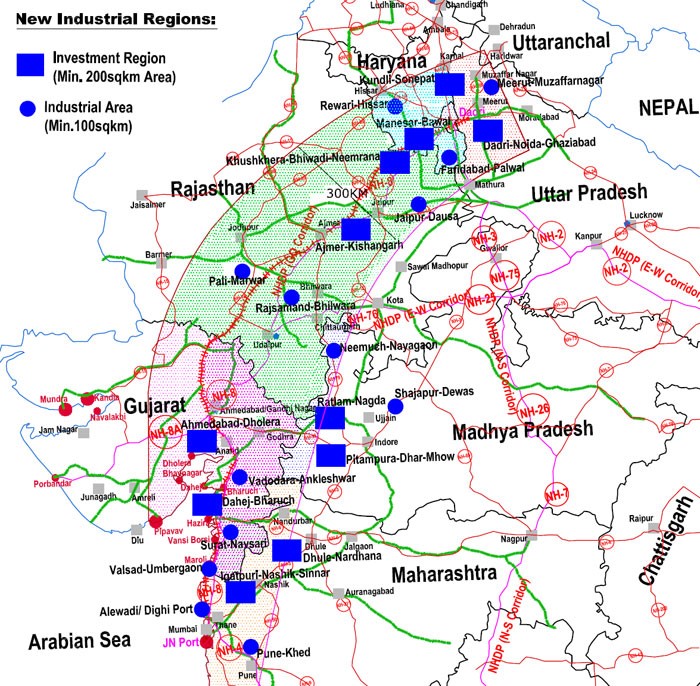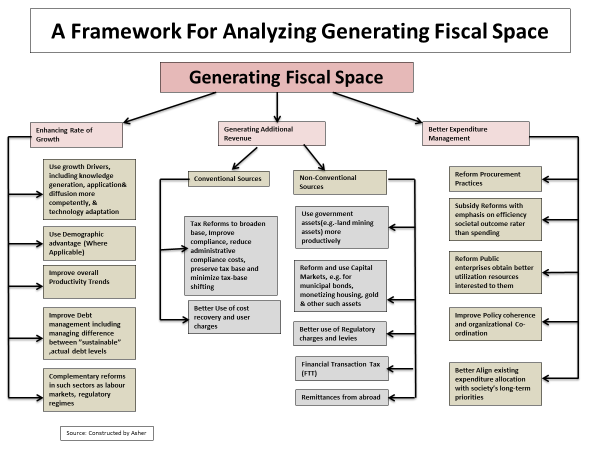How Gujarat can Sustain its Criticality and Relevance both Domestically and Globally
- In Economics
- 10:37 AM, Oct 19, 2020
- Mukul Asher
COVID-19 induced massive disruption in India brought about ongoing transformative reforms in economic, social, and political spheres. Great responsibility was devolved to the states during the health emergency when their fiscal position has been severely constrained. This has led to many states, including Gujarat, to rethink their economic development strategy to prepare for the future.
This column discusses some of the reforms which Gujarat could consider to sustain high growth, and navigate the current and prospective disruptions.
The Goal for Gujarat
The foreseeable global and domestic dynamics provide Gujarat state an opportunity to substantially enhance its criticality and relevance to India as well as globally.
Gujarat contributed 7.7% (5th largest) of India’s GDP in 2017-18, (USD 203 Billion). It constitutes around 5% of India’s population. It is suggested that Gujarat develops a strategy and competently implement specific measures to achieve a goal of contributing 10% of India’s GDP (twice its population share) well before the end of this decade. This implies that if India achieves USD 5 trillion economy goal around 2026 or 2027, Gujarat’s GDP should be then be USD 500 Billion. The planning must take this into account.
Global Changes
Key global changes, whose specifics will evolve overtime, may be briefly stated as follows:
- Trend towards Weaponization of economics, trade, finance and technology flows by key countries. Therefore, issue-based alliances with like-minded countries are needed, requiring nimble policy responses.
- Restructuring of supply and logistics chains for both goods and services, largely towards reducing their elaborateness and complexity, favouring technology-enabled shorter, simpler, and more manageable and reliable supply and logistics chains.
- Increasing recognition of the need to reduce over-dependence on one country, China, for intermediate inputs, market, technology, and finance, for business, economic, and strategic risk management.
- Covid-19 pandemic has greatly complicated these more fundamental changes, as it has created great uncertainty in global economic performance in 2020 and beyond, and is testing social resilience in many countries. Trust in leadership has become a key factor in managing the ongoing pandemic.
Developments in India
The policy responses, before the pandemic and in response to it are well known to this group. Major implications emerging from these responses for Gujarat are:
- India is evolving policies in response to global changes, captured by Atmanirbhar Bharat Abhiyan and Be -Vocal-for Local. They are designed for greater global competitiveness and enhanced confidence in Indian made products. Gujarat has brands like AMUL which are in good position to take advantage of this new thrust.
- India’s policy responses give substantially greater space than before to the states in structuring its economic, public financial management, regulatory (for agriculture, health, labour etc) responses.
- There is a shift towards greater economic freedom to economic agents, and towards greater competition, and opening up of the economy to the Indian private sector in Défense, Finance, chemical, space, education and other sectors, with key role assigned to technology adaptation and innovation.
- The indications are that within India there will be significant relocation of economic activities, and of labour. Being able to attract human resources at all levels will become more important factor in location attractiveness.
- Going forward, health infrastructure, including capabilities to produce intermediates for medicines, medical equipment of all types, and vaccines and their management, will be a strategic factor. It will have economic security, national security, and social resilience implications. Gujarat has the potential to increase its critically in this area for India and the world.
Specific Initiatives for Gujarat
- Gujarat should continue to nurture its traditional strengths in petrochemicals, pharma chemicals, tiles, diamond and jewellery, agriculture and handicrafts. Some of these sectors are likely to witness subdued demand (e.g. diamonds and jewellery). So, focus should be on diversification, and shifting to more value-added activities.
In chemical industries (and in agricultural products and Agri inputs), Gujarat must be alert that its (and India’s) competitive advantage is not eroded by counterproductive regulatory and other administrative measures, domestically or internationally.
An example is the ongoing policy discussion of banning 27 agro-chemicals proposed by the Ministry of Agriculture and being opposed by the Ministry of Chemicals and Fertilizers. Gujarat has an important economic stake as it is a major producer of these chemicals.
But use of domestic individuals and organizations to achieve commercial goals of external forces, as happened in the case of Endosulfan, a pesticide which has been successfully used for decades, will become more common in chemical and other areas. As a result, farm community is forced to use more costly, less satisfactory products from abroad. Gujarat must develop a mechanism to guards against such regulatory risks.
In pharma, greater focus should be on producing APIs (Active pharmaceutical ingredients). Developing APIs in a competitive manner will greatly enhance Gujarat’s criticality to India and to the world.
Gujarat must strategize as to which APIs, and which chemical ingredients or intermediates its industry is capable of producing competitively, and use well designed but limited industrial policy to achieve it.
TV Mohandas Pai & Nisha Holla have argued that “Gujarat is the only top-5 state with high industrial dependence at 51.8% GVA. If business-as-usual continues, Gujarat might find it problematic to keep growing when automation and other factors kick in. Instead, it must develop its services sector to augment its high industry output1”
- For an accelerated growth, Gujarat must leverage on Delhi-Mumbai Industrial Corridor (DMIC), which links to key Gujarat ports, and to JNPT (see Map 1). It also contains Special Investment region, including Dholera. This is where the opportunities lie for new domestic and foreign investment in manufacturing, and in Urban infrastructure and smart cities management systems. Gujarat is highly urbanized state, with majority of the population likely to be urban by 2030. It can increase its criticality by better urban management practices. The Special Investment Region (SIR) provides this opportunity.
Gujarat should fully leverage SMART city and AMRUT schemes designed for developing cities and urban areas for this purpose.
Tata Power has been awarded a contract to develop 100 MW solar project at Dholera Solar park. With this, the state’s renewable energy capacity under development has reached 620MW, with 400MW coming from Dholera Solar Park2.
- Gujarat should aim to obtain value addition by becoming a key hub for supply chain and logistics of the Défense industries, a new rising sector, which has become essential in the new environment. India aims to expend its defence industry exports, and Gujarat and its ports can benefit from this. Similar efforts should be made for the space sector.

Map 1
- India has been experiencing deficit in international trade in financial products and services. This is expected to grow significantly in the coming years as large infrastructure projects are being undertaken.
The new environment provides solid opportunity to give impetus to GIFT city (Gujarat International Finance Tech City) for accelerating the development of international financial services. India’s relatively underdeveloped corporate bond markets, and its miniscule municipal bond market can also be given encouragement in the GIFT city. It is already a SMART city, with excellent infrastructure, but it needs to be developed as an international financial services centre.
The International Financial Services Centres Authority (IFSCA), which will provide uniform regulations for international financial transactions, has been headquartered in Gandhinagar, Gujarat3.
There is now an opportunity to develop a Fin-Tech hub in the GIFT city, bringing technology and financial talent to Gujarat.
- Gujarat can play an important role in India’s Blue Economy plans. India is beginning to use its vast coastline, inland waterways, and ocean space for creating economic opportunities, and growth nodes. Innovative initiatives involving Sabarmati river have yielded good results. Other rivers, and ports (both major and minor) need to be focused upon for obtaining greater economic value. Kandla is witnessing major investments, but Gujarat should also encourage using other ports and rivers.
- One of the crops of immense potential value for Gujarat is cultivation of seaweed as part of the Blue Economy programs. There is ample literature about potential of seaweed, and mangroves. These can help in achieving the goal of enhancing income of farmers in coastal areas, which addressing nutritional deficiency.
- Shorter supply lines and coastal and inland shipping could provide opportunities for Gujarat ship building industry. National Authority of Ship Recycling is being set up in Gandhinagar, Gujarat. The location of the office will benefit the Ship Recycling yard owners situated in Alang. Gujarat is home of Asia’s largest ship breaking and ship recycling industry in the world4.
- Gujarat has the potential to take lead in on-line education along with traditional education. Gujarat humane treatment of Sharmiks, workers from other states, and its traditional welcoming and practical outlook, have created a goodwill which will help make it an educational hub as well.
- Gujarat has been rated as best performer overall in start-up survey by Niti Aayog in 2018 and 2019. (Asher and Singh, 2020)5.
But in some of the components, institutional leaders, procurement leaders, seeding innovation leaders, and regulatory champions, it does not figure in top 3 states.
Gujarat therefore will need to be even more strategic to sustain its ranking as other states, such as Karnataka are taking strategic initiatives in this area.
Gujarat’s initiative to build an incubation centre for 1400 start-ups at Knowledge Consortium of Gujarat is a step in the right direction6.
Setting up of INR 100 million fund by GUSEC (Gujarat University Start-Up and Entrepreneurship Council), with the support of the National science and Technology Entrepreneurship Development Board (NSTEDB) is also a step in the right direction7.
Transformative Reforms
To pursue the areas of opportunities sketched above and raise Gujarat’s share to 10% in India’s GDP. Major reforms will be needed.
The first set of broad reforms concern governance and administrative reforms at all levels. The need for them have been recognized, but have not been pursued meaningfully. Many states have not devolved the functions mandated in the 73rd and 74th Amendment to the Constitution, and have not enhanced the capacities of sub-state levels of government.
- The Centre has introduced Karmayogi scheme as a part of broader civil service reform. Among the key aims are to address lack of linkages between “Role” and ‘Competency” of the civil servants; and to make available to all civil servants, an opportunity to continuously build and strengthen their Behavioral, Functional and Domain Competencies intheir self-driven and mandated learning paths8.
Gujarat state should try to leverage on the Centre’s scheme to progress towards a more capable government through better human resource management.
- The second are concerns judicial reforms, especially those within the powers of the state, deserve attention as a competitive tool for better governance9.
- The third broad area concerns Public Financial Management (PFM) reforms.
Generating fiscal space requires understanding and planning. There are many assets of the State, including land, and better treasury management of surplus funds of urban and rural bodies, which have scope for revenue generation. Public enterprise reforms, including Utility reforms, and procurement reforms hold promise for generating fiscal space.

Figure 1
(Constructed on January 21 2020)
Figure 1 provides a suggested framework for generating fiscal space and strengthening public financial management. There are four components of the framework which need to be integrated. First is sustaining high growth, which also involves developing new growth nodes and niches. Second is to improve collection of conventional taxes, particularly GST, excise tax, and property tax levied by the state. Third is becoming more competent at unconventional sources of revenue including treasury management, and monetizing land, air space and other assets. Fourth is public expenditure management, including greater competency in procurement. Gujarat should leverage its procurement with GeM (Government electronic Marketplace of the Centre)10. Reforming public enterprises, and expenditure management.
Going forward, risk management, particularly Fiscal risk, and regulatory risk will become key aspects of management of a state’s economy. Fiscal risk management will require setting up a Gujarat Fiscal Management institute (GFMI), which works on state fiscal issues and challenges on a continuing basis. The Institute however should have some autonomy in obtaining required human talent on a contractual basis, but should be overall guided by key government officials.
- Fourth, the regulatory risk, which could affect Gujarat’s industries, need to be monitored from the Chief Minister’s office (CMO).
The CMO should also contain a technology risk assessment office. Among others, its role should be to accelerate adoption of technology in governance, and to help procure, adopt, most suitable technology for a given public policy challenge.
The above reforms will not be easy, but they will need to be competently undertaken if Gujarat is to continue to be among the leading state in the country, and maintaining its criticality and relevance both domestically and globally.
References
- https://www.financialexpress.com/opinion/indias-5-trillion-gdp-journey-contribution-of-each-state-crucial/1886918/- Accessed on 17 October 2020.
- https://www.power-technology.com/news/india-tata-power-receives-letter-award-develop-solar-project/ -Accessed on 15 October 2020
- https://www.deshgujarat.com/2020/04/28/indias-ifsc-authority-to-be-headquartered-in-gandhinagar/ -Accessed on 30 August 2020.
- https://www.deshgujarat.com/2020/10/15/national-authority-for-ships-recycling-notified-with-its-office-in-gujarat/ -Accessed on 15 October 2020
- https://www.myind.net/Home/viewArticle/2019-start-up-ecosystem-rankings-of-indian-states-Accessed on 30 September 2020
- https://ahmedabadmirror.indiatimes.com/ahmedabad/cover-story/forget-silicon-valley-gujarat-is-creating-its-own-innovation-hub/articleshow/78116197.cms -Accessed on 15 September 2020.
- https://ahmedabadmirror.indiatimes.com/ahmedabad/others/gusec-sets-up-rs-10-crore-seed-fund-for-startups/articleshow/78445542.cms?utm_source=contentofinterest&utm_medium=text&utm_campaign=cppst?utm_source=contentofinterest&utm_medium=text&utm_campaign=cppst -Accessed on 2 October 2020
- https://pib.gov.in/PressReleseDetailm.aspx?PRID=1650633 -Accessed on 15 September 2020
- Harsh Madhusudan and Rajeev Mantri, “A New idea of India” Westland Publications, 2020, pp231-247 provide a good discussion of judicial reforms needed in India.
- https://www.india.gov.in/spotlight/government-e-marketplace-procurement-made-smart#tab=tab-1-Accessed on 15 October 2020
Image Credit: DNA India







Comments